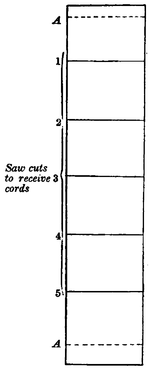The Art of Bookbinding/Chapter 4
CHAPTER IV.
Marking up and Sawing in.
The books having been in the press a sufficient time, say for a night, they are taken out, and run through again (collated) to make sure that they are all correct. A book is then taken and knocked straight both head and back and put in the lying press between boards, projecting from them about 1⁄8 inch; some binders prefer cutting boards, I prefer pressing boards, and I should advise the use of them, as the whole can be knocked up together. They should be held between the fingers of each hand, and the back and head knocked alternately on the cheek of the press. The boards are then drawn back the required distance from the back of the book: the book and boards must now be held tightly with the left hand, and the whole carefully lowered into the press; the right hand regulating the screws, which should then be screwed up tightly. The book is now quite straight, and firmly fixed in the press, and we have to decide if it is to be sewn flexibly or not. If for flexible binding the book is not to be sawn in, but marked; the difference being, that with the latter the cord is outside the sheets; with the former the cord is imbedded in the back, in the cut or groove made by the saw. We will take the flexible first, and suppose that the book before us is an ordinary 8vo. volume, and that it is to be cut all round.
The back should be divided into six equal portions, leaving the bottom, or tail, half an inch longer than the rest, simply because of a curious optical illusion, by which, if the spaces were all equal in width, the bottom one would appear to be the smallest, although accurately of the same width as the rest. This curious 
A. Saw marks for catch-up stitch. effect may be tested on any framed or mounted print. A square is now to be laid upon the back exactly to the marks, and marked pretty black with a lead pencil; the head and tail must now be sawn in to imbed the chain of the kettle stitch, at a distance sufficient to prevent the thread being divided by accident in cutting. In flexible work great accuracy is absolutely necessary throughout the whole of the work, especially in the marking up, as the form of the bands will be visible when covered. It will be easily seen if the book has been knocked up straight by laying the square at the head when the book is in the press, and if it is not straight, it must be taken out and corrected. If the book is very small, as for instance a small prayer book, it is usually marked up for five bands, but only sewed on three; the other two being fastened on as false bands when the book is ready for covering. There would be no gain in strength by sewing a small book on fine bands.
When the book is to be "sawn in," it is marked up as for flexible work, but the back is sawn, both for the bands and kettle stitch, with a tennon saw. In choosing the saw, it should be one with the teeth not spread out too much; and it is advisable to have two of different widths. Care must be taken that the saw does not enter too deeply, and one must, in all cases, be guided in the depth by the thickness of the cord to be used. The size of the book should determine the thickness of the cord, as the larger the book, the stronger and thicker must be the cord. Suitable cord is to be purchased at all the bookbinder's material shops, and it is known by the size of the book, such as 12mo., 8vo., 4to. cord.

Sawing-in Machine.
I think nothing looks worse than a book with great holes in the back, sometimes to be seen when the book is opened, which are due to the inattention of the workmen. Besides, it causes great inconvenience to the forwarder if the cords are loose, and the only thing he can do in such a case is to cram a lot of glue into the grooves to keep the cord in its place. If, on the other hand, the saw cuts are not deep enough, the cord will stand out from the back, and be distinctly seen when the book is finished, if not remedied by extra strips of leather or paper between the bands when lining up. It is better to use double thin cord instead of one thick one for large books, because the two cords will lie and imbed themselves in the back, whereas one large one will not, unless very deep and wide saw cuts be made. Large folios should be sawn on six or seven bands, but five for an 8vo. is the right number, from which all other sizes can be regulated.
Saw benches have been introduced by various firms. They can be driven either by steam or foot. It will be seen that the saws are circular, and can be shifted on the spindle to suit the various sized books. As the books themselves are slid along the table on the saws, the advantage is very great in a large shop where much work of one size is done at a time.
